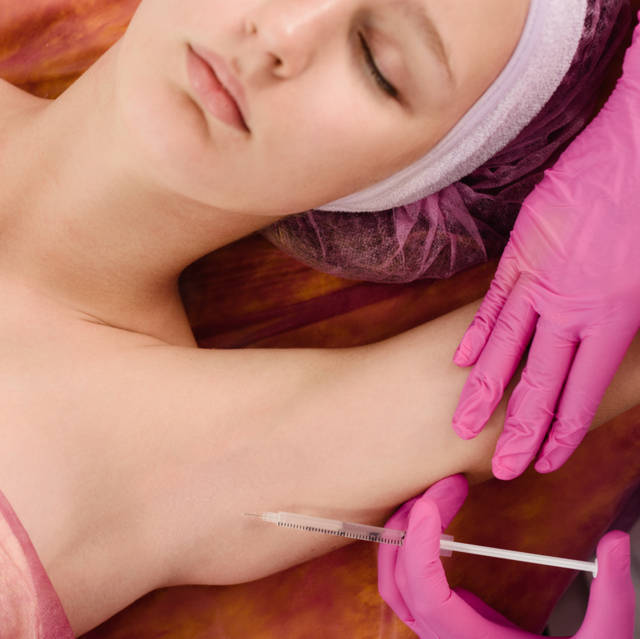Hyperhidrosis
Hyperhidrosis is associated with a deterioration in quality of life.
Hyperhidrosis - What it is;
Hyperhidrosis is a condition characterized by unusually increased sweating, above that required to regulate body temperature. Hyperhidrosis is associated with a burden on the quality of life with psychological, emotional and social implications.
Classification
Hyperhidrosis can be either generalized or localized.The arms, legs, armpits, and groin area are the areas with the largest number of sweat glands.When excessive sweating is localized (eg palms, soles, face, armpits, scalp) it is referred to as primary hyperhidrosis or focal hyperhidrosis. Excessive sweating involving the whole body is termed generalized hyperhidrosis or secondary hyperhidrosis. It is usually the result of some other, underlying condition.Primary or focal hyperhidrosis may be further divided by the area affected, for instance palmoplantar hyperhidrosis (symptomatic sweating of only the hands or feet) or gustatory hyperhidrosis (sweating of the face or chest a few moments after eating certain foods).Η υHyperhidrosis can also be classified by onset, either congenital (present at birth) or acquired (beginning later in life).Primary or focal hyperhidrosis usually starts during adolescence or even earlier and seems to be inherited as an autosomal dominant genetic trait.It must be distinguished from secondary hyperhidrosis, which can start at any point in life.Secondary hyperhidrosis may be due to a disorder of the thyroid or pituitary glands, diabetes mellitus, tumors, gout, menopause, certain drugs, or mercury poisoning.

Causes
The cause of primary hyperhidrosis is unknown, although some claim it is caused by hyperactivity of the sympathetic nervous system. Anxiety or agitation can worsen the condition for many sufferers. Patients report being stressed because they sweat and then sweating more. Other factors that may play a role include certain foods and beverages, nicotine, caffeine, and odors.
Primary causes of hyperhidrosis
Idiopathic unilateral described hyperhidrosis
Association with:
Blue spot
Glomangioma
Poems syndrome
Foot burning syndrome
Burning pain
Pachydermoperiostosis
Tibial myxedema
Tasteful sweating is related to:
Encephalitis
Syringomyelia
Diabetic neuropathy
Shingles
Cheeks
Parotid abscesses
Chest sympathectomy
Secondary (generalized) hyperhidrosis
has many causes, including certain types of cancer, endocrine disorders, infections, and medications.
Cancers associated with the development of secondary hyperhidrosis include lymphoma, pheochromocytoma, carcinogenic tumors (resulting in carcinoid syndrome), and tumors within the thoracic cavity.
Endocrine. Certain endocrine conditions cause secondary hyperhidrosis including diabetes mellitus (especially when blood sugar is low), acromegaly, hyperplasia, and various forms of thyroid disease.
Drugs such as selective serotonin reuptake inhibitors (eg, sertraline), tricyclic antidepressants, opioids, non-steroidal anti-inflammatory drugs (NSAIDs), glyburide, insulin, anxiolytic agents, inactivating agonists, and inactive agonists. In people with a history of spinal cord injuries
Orthostatic hypotension
Post-traumatic syringomyelia
Association with peripheral neuropathies
Familial dysautonomy
Congenital dysfunction of the autonomic with universal loss of pain
Exposure to the cold, connection with possible brain damage
Episodic with hypothermia (Hines and Bannick syndrome)
Episodic without hypothermia
Olfactory
Association with systemic medical problems
Parkinson's disease
fibromyalgia
Congestive heart failure
Anxiety
state of menopauseς
Night sweats
Infantile dementia caused by chronic exposure to low-dose mercury, leading to accumulation of catecholamines and resulting in a pheochromocytoma-like clinical picture.
Diagnosis
Symmetry of excessive sweating is associated with primary hyperhidrosis. If excessive sweating affects only one side of the body it is an indication of secondary hyperhidrosis and further research is recommended to find a neurological cause.
Treatment
Pharmaceutical
Aluminum chloride is widely used in deodorants. However, hyperhidrosis requires a much higher concentration of the ingredient. These deodorants are particularly effective in treating the axillary area. It normally takes about three to five days to see improvement. The most common side effect is skin irritation. For severe cases of plantar and palmar hyperhidrosis, there has been some success with precautionary measures, such as higher concentrations of aluminum chloride antiperspirants. Oral anticholinergics are sometimes used to treat both generalized and focal hyperhidrosis. These include propantheline, glycopyrrone bromide, oxybutynin, methaneline, and benzatropine.The use of these drugs should be limited due to possible side effects such as dry mouth, urinary retention, constipation, and visual disturbances such as mydriasis and cycloplegia. For people who find their hyperhidrosis aggravated by stress (public speaking, theatrical performances, special events such as weddings, etc.), taking an anticholinergic before the event may be helpful.
Invasive
Botulinum toxin type A injections (Dysport) can be used to block the neuronal control of sweat glands. The effect can last for 3 to 9 months, depending on the location of the injections. The duration of the beneficial effect on primary palmar hyperhidrosis increases with repeated injections.Botulinum toxin injections tend to be painful. Various measures have been tried to minimize pain, one of which is the application of ice.
Surgery
In addition to the surgical removal of the glands presented in another chapter, the other major surgical option is endoscopic thoracic sympathectomy (ETS), by cauterizing, cutting, or tightening the thoracic ganglion in the central sympathetic chain running parallel to the sternum. It is generally considered a safe method, and most patients are satisfied with the results of the surgery.
Prevention
Hyperhidrosis can have consequences, such as cold and wet hands, dehydration and skin infections due to wetting. It can also affect your personal-emotional life. Patients are constantly aware of their condition and try to change their lifestyle. Too much routine work can lead to a disproportionate amount of sweating. The safe grip of objects,e.g. knife is not possible. Patients avoid situations where they come into physical contact with others, such as greeting with a handshake. In severe cases, the shirts must be changed several times during the day and additional showers are required both to remove sweat and body odor. Problems such as acne, dandruff, or athlete's foot occur or worsen. Excessive sweating of the feet makes it difficult for patients to wear open shoes, sandals because they can slip.The risk of dehydration may limit the ability of some sufferers to operate in extremely hot (especially wet) conditions.
Surgical treatment of sweat adenitis and hyperhidrosis
Hyperhidrosis
Hyperhidrosis is a common problem that affects both leaves. It is treated either with topical application of drugs that reduce the intensity of the phenomenon, or with injections of Botulinum toxin (Botulinum toxin) in the area (usually armpits, hands). A permanent result in the hyperhidrosis of the axillary country is the removal of a part of the skin of the area together with a part of the sweat glands. It is done under local anesthesia and leaves a barely visible scar.
Sweating
Sweating is often an intractable problem that reduces a patient's quality of life. Although there are many treatment options, they often fail to treat severe forms of the disease. Surgical removal of part of the area and its secondary healing are the method of choice for the refractory forms of the disease.


